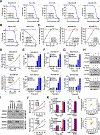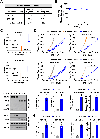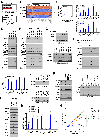Targeted MDM2 Degradation Reveals a New Vulnerability for p53-Inactivated Triple-Negative Breast Cancer
- PMID: 36734633
- PMCID: PMC10164114
- DOI: 10.1158/2159-8290.CD-22-1131
Targeted MDM2 Degradation Reveals a New Vulnerability for p53-Inactivated Triple-Negative Breast Cancer
Erratum in
-
Correction: Targeted MDM2 Degradation Reveals a New Vulnerability for p53-Inactivated Triple-Negative Breast Cancer.Cancer Discov. 2023 Jul 7;13(7):1748. doi: 10.1158/2159-8290.CD-23-0550. Cancer Discov. 2023. PMID: 37416993 No abstract available.
Abstract
Triple-negative breast cancers (TNBC) frequently inactivate p53, increasing their aggressiveness and therapy resistance. We identified an unexpected protein vulnerability in p53-inactivated TNBC and designed a new PROteolysis TArgeting Chimera (PROTAC) to target it. Our PROTAC selectively targets MDM2 for proteasome-mediated degradation with high-affinity binding and VHL recruitment. MDM2 loss in p53 mutant/deleted TNBC cells in two-dimensional/three-dimensional culture and TNBC patient explants, including relapsed tumors, causes apoptosis while sparing normal cells. Our MDM2-PROTAC is stable in vivo, and treatment of TNBC xenograft-bearing mice demonstrates tumor on-target efficacy with no toxicity to normal cells, significantly extending survival. Transcriptomic analyses revealed upregulation of p53 family target genes. Investigations showed activation and a required role for TAp73 to mediate MDM2-PROTAC-induced apoptosis. Our data, challenging the current MDM2/p53 paradigm, show MDM2 is required for p53-inactivated TNBC cell survival, and PROTAC-targeted MDM2 degradation is an innovative potential therapeutic strategy for TNBC and superior to existing MDM2 inhibitors.
Significance: p53-inactivated TNBC is an aggressive, therapy-resistant, and lethal breast cancer subtype. We designed a new compound targeting an unexpected vulnerability we identified in TNBC. Our MDM2-targeted degrader kills p53-inactivated TNBC cells, highlighting the requirement for MDM2 in TNBC cell survival and as a new therapeutic target for this disease. See related commentary by Peuget and Selivanova, p. 1043. This article is highlighted in the In This Issue feature, p. 1027.
©2023 American Association for Cancer Research.
Conflict of interest statement
Figures







Comment in
-
MDM2-PROTAC versus MDM2 Inhibitors: Beyond p53 Reactivation.Cancer Discov. 2023 May 4;13(5):1043-1045. doi: 10.1158/2159-8290.CD-23-0229. Cancer Discov. 2023. PMID: 37139722
References
Publication types
MeSH terms
Substances
Grants and funding
LinkOut - more resources
Full Text Sources
Molecular Biology Databases
Research Materials
Miscellaneous

